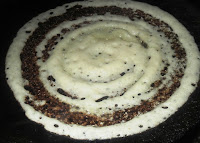Tatte Idli/plate idli is also called majjige/mosaru idli. It is prepared using mosaru/curd or majjige/butter milk. In this particular type of idli we do not use much of Urid dal.
We do this kadabu/idli back at home in South Canara and Malnad area. (Karnataka). It is one of the healthy dish for breakfast and its easy too. Recently I have seen Mr. Sadananda Mayya the owner of Mayya's group of Hotels showing the recipe in one of the T. V. Channel. Then I thought I should put up this recipe here. I have tried this many times and the result is super soft idlis.
The ingredients used here are raw rice, curd or butter milk and avalakki/flattened rice. (Avalakki). You can add grated ginger and carrots .
Thick Avalakki : 1 Cup
Urid dal : 1 Tablespoon
Curd : 3/4 cup
Salt : as it required
2. Wash and soak Avalakki/flattened rice for at least 1 hour.
3. Now grind avalakki/flattened rice in 1/2 cup of curd/butter milk till smooth.
4. Add rice to this avalakki and grind it as rava. (not fully in to paste).
5. Remove the ground mixture from the mixi jar and put it in a big bowl.
6. Add required salt and leave it for fermenting.
7. Apply oil on the plates or cooker container. Mix this mixture nicely and pour it to the plates.
8. Keep a idli cooker/pressure cooker on the fire and put some water into it.
9. Let the water boil. Keep these dough poured plates in the idli cooker and cook for 15 to 20 minutes.
10. Insert a spoon edge to know idli is cooked well. (if the dough sticks by the sides of the inserted spoon then cook for another 10 minutes).
11. Remove from idli plate and cut the idli in to small pieces.
12. Serve with ghee and the side dish you prepared.
You can add grated carrots, ginger, coconut pieces, curry leaves, cut green chilly and coriander leaves (cut into thin) to the dough (just before preparing idli) and prepare masala tatte idli.
Do not add any bicarbonate soda or baking powder and Eno salt. It takes away the natural aroma.
Be careful while eating outside. They might use ajino moto (a type of chinese salt) (taste powder as they call) to pull the crowd. Ajinomoto is a kind of salt which is not good for our health and it damages our intestine.
Time : Total time : 7 hours & 40 minutes.
Soaking time : 2 hours
grinding : 10 minutes
Fermenting time : 5 to 6 hours.
Cooking Time : 20 minutes.
Serves : 5 to 6.
We do this kadabu/idli back at home in South Canara and Malnad area. (Karnataka). It is one of the healthy dish for breakfast and its easy too. Recently I have seen Mr. Sadananda Mayya the owner of Mayya's group of Hotels showing the recipe in one of the T. V. Channel. Then I thought I should put up this recipe here. I have tried this many times and the result is super soft idlis.
The ingredients used here are raw rice, curd or butter milk and avalakki/flattened rice. (Avalakki). You can add grated ginger and carrots .
Things Needed :
Raw Rice : 2 CupsThick Avalakki : 1 Cup
Urid dal : 1 Tablespoon
Curd : 3/4 cup
Salt : as it required
Method :
1. Wash and soak rice and urid dal for 2 to 3 hours.2. Wash and soak Avalakki/flattened rice for at least 1 hour.
3. Now grind avalakki/flattened rice in 1/2 cup of curd/butter milk till smooth.
4. Add rice to this avalakki and grind it as rava. (not fully in to paste).
5. Remove the ground mixture from the mixi jar and put it in a big bowl.
6. Add required salt and leave it for fermenting.
7. Apply oil on the plates or cooker container. Mix this mixture nicely and pour it to the plates.
8. Keep a idli cooker/pressure cooker on the fire and put some water into it.
9. Let the water boil. Keep these dough poured plates in the idli cooker and cook for 15 to 20 minutes.
10. Insert a spoon edge to know idli is cooked well. (if the dough sticks by the sides of the inserted spoon then cook for another 10 minutes).
11. Remove from idli plate and cut the idli in to small pieces.
12. Serve with ghee and the side dish you prepared.
Note :
You can use tatte idli stand to prepare this idlis/cooker container or small plates.
The dough must be fermented well. The consistency of the dough turns little watery. Not to worry. It is because of curd and Avalakki the dough turns as little watery. Use only the required curd. Do not grind the ingredients into watery. (Let it be thick when groun, since curd is added the dough turns little watery). That is the reason we use plates.You can add grated carrots, ginger, coconut pieces, curry leaves, cut green chilly and coriander leaves (cut into thin) to the dough (just before preparing idli) and prepare masala tatte idli.
Do not add any bicarbonate soda or baking powder and Eno salt. It takes away the natural aroma.
Be careful while eating outside. They might use ajino moto (a type of chinese salt) (taste powder as they call) to pull the crowd. Ajinomoto is a kind of salt which is not good for our health and it damages our intestine.
Time : Total time : 7 hours & 40 minutes.
Soaking time : 2 hours
grinding : 10 minutes
Fermenting time : 5 to 6 hours.
Cooking Time : 20 minutes.
Serves : 5 to 6.

























































